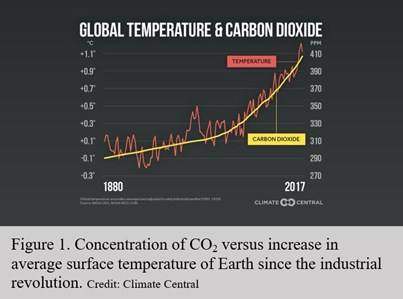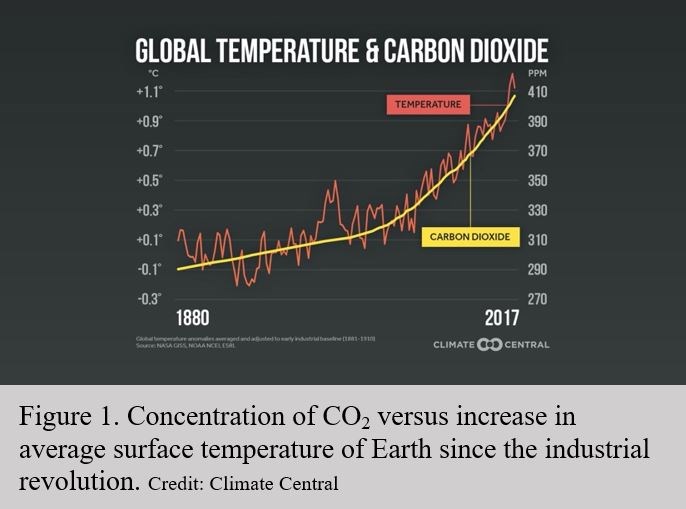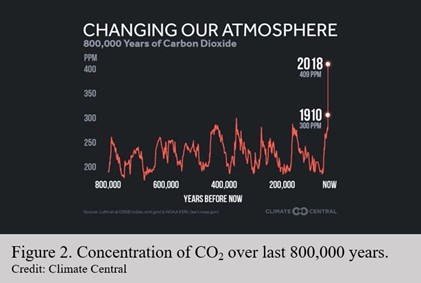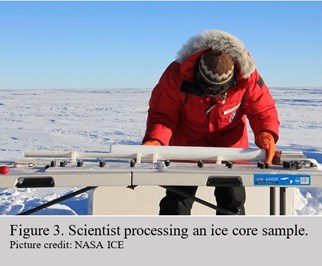Tackling Climate Change Denialism
Thursday, January 2, 2020An Albertan Narrative of Climate Change
Canada is a world leader in science and technology, producing cutting edge scientific innovation from the agricultural industry to the oil sands. This innovation has enabled Alberta’s oil industry to prosper resulting in job creation, revenue generation, and production of 64% of Canada’s total oil and gas supply, which not only help us in meeting our national energy needs but also international demands. Further, showcasing a concern for the environment, Alberta’s oil sands developers have achieved a 21% reduction in their greenhouse gas emissions (per barrel) between 2009-2017 using made in Canada technology. Yet, despite achieving these scientific feats, a significant portion of our society is unsure about one particular branch of science, climate change science.
Due to our strong scientific background, Canadians should be leading international climate change action, but instead, climate change denialism is still prevalent in many parts of this country. In Alberta, for example, 54% individuals attribute climate change with human activity while 46% believe in a nature driven climate change (as shown in a 2018 survey). In this blog, we will explore the science behind the climate change and answer questions related to climate change denialism.
Denial Arguments vs. Climate Science
When it comes to climate change denialism, there are two major viewpoints between which all the other arguments exist. On one side there is the argument that climate change is a hoax. The other side, that the climate has changed before and it is a natural process, therefore, we need not to worry about it. Let us analyze these two arguments, look at the science, and examine some other scepticisms that exists between these two arguments.
Denial Argument 1. Climate Change is a hoax. If the climate is changing and warming, how come we still experience extremely cold temperatures in the winter?
Climate is hardly a stable phenomenon. It is a dynamic process influenced by various factors on the planet ranging from volcanos to humans. However, evidence suggests that the climate is currently changing for worse and it is caused by human activity. This climate change, to a great extent, started during the industrial revolution, i.e., in the latter half of 18th century. Since then, we have been burning increasing amounts of fossil fuels and releasing increasing amounts of greenhouse gases into the atmosphere. As a result, our planet is warming up at an increasing rate. Figure 1 visualize this phenomenon.


In order to answer second part of the question, we need to understand the difference between climate and weather. What we experience every day is not climate, but weather. Weather is the varying environmental conditions that we experience on a day to day basis, such as rain, wind, and sunshine; while climate change is the longterm trends, i.e., 30-year intervals, of various atmospheric phenomenon, such as temperature, precipitation, and humidity. Therefore, even though the climate is changing, i.e. the Earth is getting warmer, we can still experience cold temperatures on a daily basis. This does not mean, however, that climate change does not impact our lives on daily basis. Predictions of climate change are that extreme weather will become more frequent, for longer time periods and more intense. For instance, on average, scientists are seeing warmer winters across much of North America due to climate change, but also more intense winter storms. Environmental extremes, such as forest fires in Alberta and Australia, are also being amplified by climate change, impacting peoples’ lives. As the rate of climate change increases, these impacts will be felt more and more on a day to day basis by more and more people in various parts of the world.
Denial Argument 2. Climate Change is a natural phenomenon; therefore, is not caused by humans.
It is true that the global climate has changed before naturally. Earth has experienced several ice ages and warming periods in the past 800,000 years. Figure 2 illustrates this phenomenon. Scientists believe that these changes are related to changes in volcanic activity, plate tectonics, Earth’s orbit and axis, and meteor strike. However, this does NOT confirm skeptics’ claim that the current climate change is natural. Looking at figure 2 we can see that the current shift in CO2 levels started right when the industrial revolution took off. However, we have an even more conclusive proof that climate change is caused by human activity by examining ice geochemistry.

When paleontologists study dinosaurs, they dig through the dirt. But when scientists study climate change, they have to dig into the ice. Places like Antarctica and the Arctic have accumulated ice over thousands of years. Scientists dig into the ice, harvest ancient ice samples, and study the chemical composition of ancient air bubbles trapped inside. These air bubbles become a window into the past through which scientists can look back and study the climate history of our planet. But how exactly do they do that? Using a process called isotopic fingerprinting, scientists study greenhouse gases like carbon dioxide. Generally, we understand carbon in CO2 to be one type of carbon, when in fact, there are three different types of carbons, 12C, 13C, and 14C with different atomic weights. Different sources of carbon, from volcanos to fossil fuels, have a different ratio of these three types of carbon. This is how scientists know that the current carbon sources fueling today’s climate change are from fossil fuel emissions.
Denial Argument 3. Carbon Dioxide is plant food, therefore, it is good for the planet.
Recent studies have shown a slight greening of the Earth due to rising CO2 concentration. While this is true, and we have a potentially greener earth in some areas of the world, climate change and rising CO2 concentration in the atmosphere still have an overall negative impact on the planet. These impacts include rising sea levels, droughts, forest fires, and melting glaciers. In the oceans, CO2 is dissolved to create more acidic water that is inhibiting marine plants, phytoplankton, which is a major source of O2 in our atmosphere. The loss of phytoplankton also impacts the marine food chain resulting in less food for fish.
 Denial Argument 4. There is no scientific consensus on climate change.
Denial Argument 4. There is no scientific consensus on climate change.
Some people believe that scientists are divided on climate change with no conclusive consensus on the issue. This, in fact, is not true. Various studies have shown that 97% of the climate scientists agree that our current climate change is caused by human activity. Furthermore, leading scientific organizations such as Canadian Medical Association - the largest organization of medical experts in the country, supports the science of climate change. The International Panel on Climate Change, an agency of the United Nations is the best source for scientific information about global climate changes https://www.ipcc.ch/about/
Denial Argument 5. Other countries, like China, are to be held responsible for climate change, not small emitters like Canada.
Climate change is an overarching issue which impacts the whole planet. This problem can only be solved by all countries taking a collective action. Therefore, while China will have to reduce its collective Greenhouse Gas emission (GHG), since it is one of the largest emitters as a country, Canadians also need to reduce their GHG emissions since our per capita [per person] emissions are one of the highest in the world and much greater than China’s per capita emissions.
What Can Albertans Do?
There are a number of things that Albertans can do to tackle climate change. We can support green industry, such as solar energy and wind generators. Green technologies can help us achieve our provincial and national carbon emissions target, diversify our economy, and create new jobs. Berkshire Hathaway Energy, for example, recently announced a $200 million investment project for southern Alberta. They intend to build a windfarm capable of producing enough energy to power 79,000 houses. Individuals can also reduce their daily carbon footprint by reducing use of personal vehicles by walking and taking public transit when possible. We can reduce our home usage of electricity with efficient light bulbs and appliances, and save money and energy by simply turning off appliances and lights when not needed. This Alberta government website also has many good ideas https://www.alberta.ca/climatechange-alberta.aspx
Picture credit:
Winter Force Media, retrieved on Dec 23, 2019, source Own Work, retrieved from
https://commons.wikimedia.org/wiki/File:Farm_Hwy_37_Alberta_Canada_02A.jpg
Climate Central, retrieved on Dec 23, 2019, retrieved from https://www.climatecentral.org/gallery/graphics/800000-years-of-carbon-dioxide
Climate Central, retrieved on Dec 23, 2019, retrieved from https://www.climatecentral.org/gallery/graphics/co2-and-rising-global-temperatures
NASA ICE, retrieved on Dec 23, 2019, source ICE core vitals, retrieved from https://commons.wikimedia.org/wiki/File:Ice_Core_Vitals_(5433412179).jpg
Helle Astrid, Kjaer, retrieved on Dec 23, 2019, source Own Work, retrieved from https://commons.wikimedia.org/wiki/File:Shallow_ice_core_drilling_(danish_Hans_Tausen_drill)_1.jpg
Additional Readings
https://www.saveonenergy.com/green-energy/
https://www.eia.gov/tools/faqs/faq.php?id=709&t=6
https://ecofiscal.ca/wp-content/uploads/2018/04/Ecosfiscal_Polling_February2018_FINAL_RELEASE.pdf
https://www.alberta.ca/oil-sands-facts-and-statistics.aspx
https://climate.nasa.gov/news/649/secrets-from-the-past-point-to-rapid-climate-change-in-the-future/
https://www.wwf.org.uk/updates/10-myths-about-climate-change
https://www.nature.com/articles/nclimate3004
https://www.ncei.noaa.gov/news/weather-vs-climate
https://www.climate.gov/news-features/blogs/beyond-data/warming-winters-across-united-states
https://www.bgs.ac.uk/discoveringGeology/climateChange/general/causes.html
https://e360.yale.edu/digest/co2-concentrations-hit-highest-levels-in-3-million-years
https://earthobservatory.nasa.gov/features/CarbonCycle/page4.php
https://www.esrl.noaa.gov/gmd/ccgg/isotopes/chemistry.html
https://climate.nasa.gov/news/2616/core-questions-an-introduction-to-ice-cores/
https://journals.sagepub.com/doi/pdf/10.1177/2053019614541631
https://www.esrl.noaa.gov/gmd/outreach/isotopes/mixing.html
https://www.scientificamerican.com/article/how-are-past-temperatures/
http://www.antarcticglaciers.org/glaciers-and-climate/ice-cores/ice-core-basics/
https://www.bgc.mpg.de/service/iso_gas_lab/publications/PG_WB_IJMS.pdf
https://climate.nasa.gov/news/2436/co2-is-making-earth-greenerfor-now/
https://www.cma.ca/canadian-medical-association-cma-pushes-make-climate-change-health-priority
https://climate.nasa.gov/scientific-consensus/#*
https://www.ncbi.nlm.nih.gov/pmc/articles/PMC2901439/
https://www.nature.com/immersive/d41586-019-02711-4/index.html
https://www.iea.org/fuels-and-technologies/renewables
Blog Posts
- What is Climate Change
- Drought: What Can We Do?
- Migration and Climate Change; a Complicated Relationship (Part 1)
- Migration and Climate Change; a Complicated Relationship (Part 2)
- Climate Change and Birds’ Resources
- Ladder to Extinction
- Arctic Warming and Ecosystem Impacts
- Climate Change Connection to Mountain Pine Beetle
- Tackling Climate Change Denialism
- Impact of Climate Change on Bluebirds
- An Introduction to Climate Change
- Great Decline of Aerial Insectivores
- Role of Oceans in Fighting Climate Change
- Role Of Forests In Fighting Climate Change
- Impact of Climate Change on Shorebirds
- Impact of Hurricanes and Climate Change on Birds
- An Introduction to Climate Change.
- Impact of Forest Fires, and Climate Change on the Nature
- Impacts of Climate Change on Owls
- Impacts of Climate Change on Birds of Prey
- Whitebark Pine and Clark's Nutcracker
- COVID 19 & The Environment
- Impact of Global Warming on Bird Anatomy and Colour Polymorphism
- Climate Change & West Nile Virus
- All Posts

